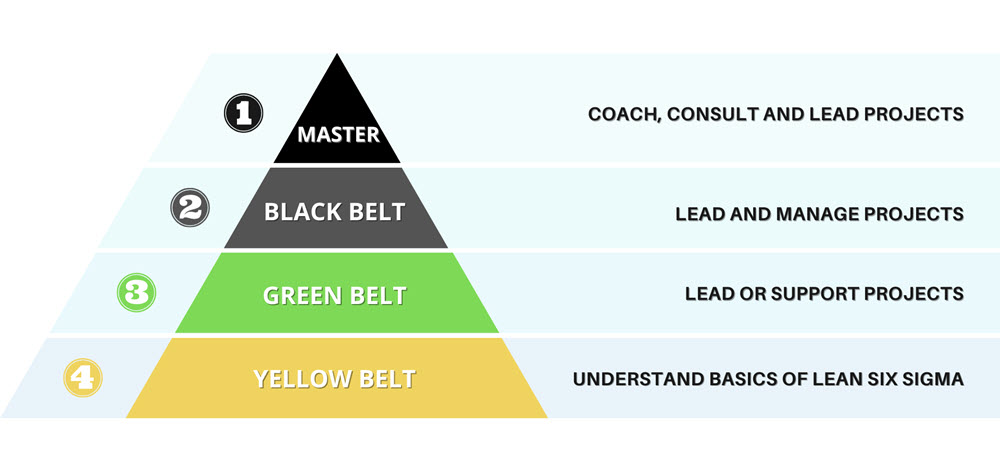Lean Six Sigma is a methodology that focuses on improving business processes and reducing defects and inefficiencies. It combines the principles of Lean, which aims to eliminate waste, with the statistical analysis techniques of Six Sigma. A Lean Six Sigma certification can enhance your career prospects and make you a valuable asset in various industries. In this article, we will guide you through the steps to obtain the certification, helping you to boost your professional qualifications and skills.
Understanding Lean Six Sigma Certification
Before you embark on your journey to obtain a certification, it’s crucial to understand what it entails. Lean Six Sigma certifications come in various levels, such as White Belt, Yellow Belt, Green Belt, Black Belt, and Master Black Belt. Each level signifies a different level of expertise and responsibility within the Lean Six Sigma framework. Here’s a brief overview of the various certification levels.
White Belt
- White Belt certification is the basic level of Lean Six Sigma.
- It provides a foundational understanding of the methodology.
- White Belts typically support process improvement projects but may not lead them.
Yellow Belt
- Yellow Belt certification builds upon the White Belt level.
- Yellow Belts have a deeper understanding of Lean Six Sigma principles.
- They often work as team members in improvement projects led by Green or Black Belts.
Green Belt
- Green Belt certification represents a higher level of expertise.
- Green Belts can lead small to medium-sized improvement projects.
- They are responsible for data collection, analysis, and implementing solutions.
Black Belt
- Black Belt certification is a significant achievement in Lean Six Sigma.
- Black Belts can lead large and complex projects.
- They are experts in data analysis and problem-solving, often working full-time on improvement projects.
Master Black Belt
- Master Black Belt is the highest level of Lean Six Sigma certification.
- Master Black Belts are experts who mentor and train other Belt levels.
- They have a profound knowledge of the methodology and its application.
Now that you have an understanding of the different Lean Six Sigma certification levels, let’s explore the steps to obtain one.
Steps to Obtain a Lean Six Sigma Certification
Step 1: Decide Your Certification Level
The first step in getting the certification is to decide which level is most suitable for your career goals and current skill level. If you’re new to Lean Six Sigma, starting with a White or Yellow Belt certification can be a good choice. However, if you have prior experience and are looking to advance in your career, you may consider pursuing a Green, Black, or Master Black Belt certification.
Step 2: Choose an Accredited Training Provider
To get a Lean Six Sigma certification, you’ll need to complete a training program from an accredited provider. There are numerous organisations and institutions that offer Lean Six Sigma training, both in-person and online. Ensure that the training provider you choose is recognised and respected in the industry to ensure the credibility of your certification.
Step 3: Enrol in a Training Program
Once you’ve selected a training provider, enrol in a Lean Six Sigma training program that aligns with your chosen certification level. Training programs typically consist of classroom instruction, practical exercises, and exams to evaluate your understanding of the methodology. Depending on the certification level, the training duration may vary from a few days to several weeks.
Step 4: Attend the Training
During your training, you will learn the principles and techniques of Lean Six Sigma, such as DMAIC (Define, Measure, Analyse, Improve, Control) and tools like process mapping, statistical analysis, and root cause analysis. Pay close attention and actively participate in the training to gain a solid grasp of the methodology.
Step 5: Pass the Certification Exam
After completing the training, you will need to pass a certification exam to demonstrate your knowledge and skills. The exam may consist of multiple-choice questions, practical exercises, and case studies. Be well-prepared and review your training materials to increase your chances of success.
Step 6: Complete a Lean Six Sigma Project (For Some Levels)
At higher certification levels, such as Green Belt and Black Belt, you may be required to lead a Lean Six Sigma project from start to finish. Successfully completing a project that meets the defined criteria is often a prerequisite for obtaining these certifications. Ensure that you follow the DMAIC process and apply Lean Six Sigma tools effectively in your project.
Step 7: Receive Your Lean Six SigmaCertification
Once you’ve passed the exam and, if applicable, completed a Lean Six Sigma project, you will receive your certification. Your certification may be issued by the training provider, an industry organisation, or a recognised certification body. Make sure to keep a copy of your certification for your records and update it as needed.
Conclusion
In summary, obtaining a Lean Six Sigma certification can open doors to exciting career opportunities and demonstrate your expertise in process improvement and problem-solving. Choose your certification level, select a reputable training provider, and commit to the training and exam preparation. With determination and hard work, you can become a certified Lean Six Sigma professional and make a significant impact on the success of your organisation or industry. Good luck on your Lean Six Sigma certification journey!






